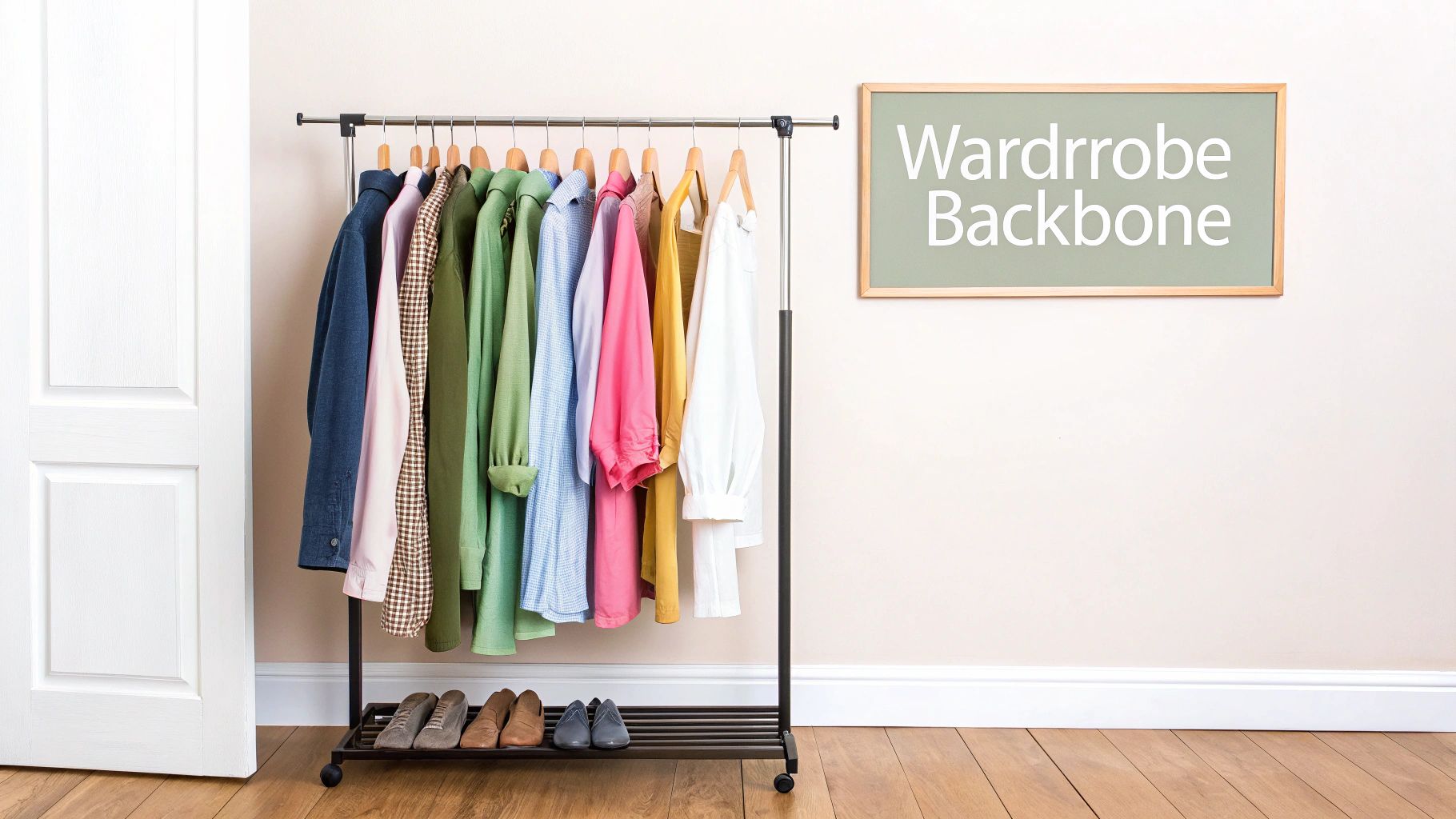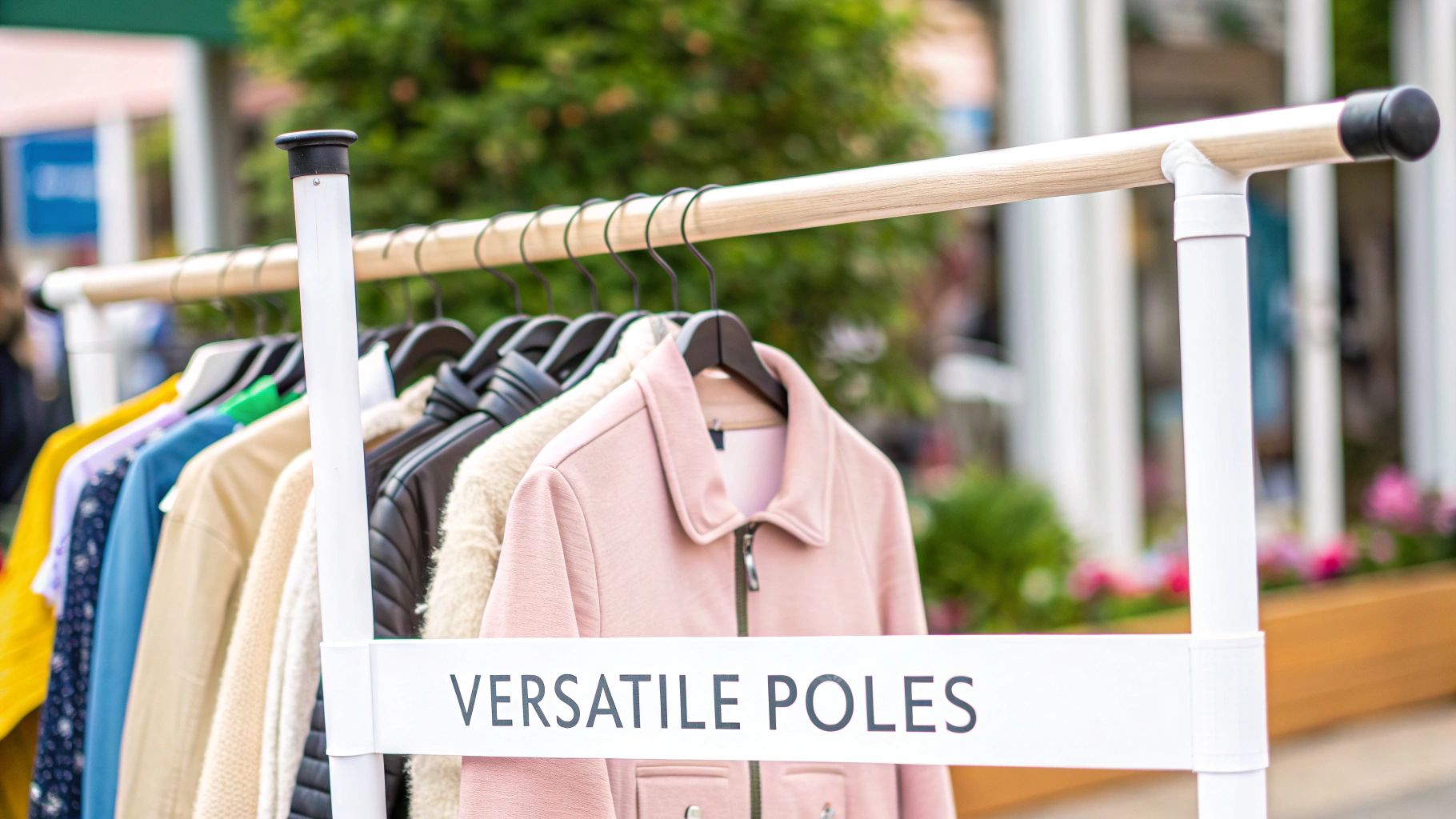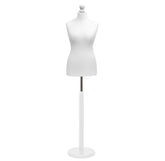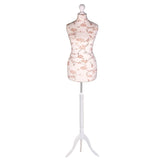Choosing the Best Clothes Hanging Poles
It's easy to think of a clothes hanging pole as just a metal bar, but the right one is genuinely the backbone of any organised space. What started as a basic household necessity has grown into a key component in modern home design and professional retail displays. A well-chosen pole is often the only thing standing between a beautifully organised wardrobe and a chaotic, sagging mess.
The Unsung Hero of Wardrobe Organisation

Often taken for granted, the humble clothes hanging pole is a fundamental tool for keeping things in order. Its job is simple but absolutely vital: supporting your clothes, keeping them free of wrinkles, and making sure everything is easy to see and grab. But its role goes far beyond pure function; it plays a part in the efficiency and even the look of a room.
Choosing the right pole can dramatically increase your storage capacity, protect your clothes from damage, and even add to your room's aesthetic. The decision is about more than just finding a rail that fits the space; it’s about understanding what makes it reliable for the long haul.
Key Considerations for Your Pole
A few crucial factors separate a flimsy, sagging rail from a sturdy, long-lasting solution. Before you get into the details, it's worth getting to grips with these foundational elements:
- Material Strength: The material of the pole—whether it’s steel, wood, or aluminium—directly affects its durability and how much weight it can handle.
- Pole Diameter: It's simple physics, really. A thicker diameter gives the pole greater structural integrity, stopping it from bowing under the weight of heavy winter coats or a full collection of suits.
- Mounting Style: How the pole is fixed to the walls or inside a wardrobe determines its overall stability and safety.
This renewed focus on quality storage isn't just anecdotal; it's reflected in market trends. In the UK, the demand for organised storage solutions like hangers and poles is growing steadily, with a projected compound annual growth rate of around 4.5% to 4.6% through the early 2030s. This really highlights a clear shift towards people investing in durable, effective organisation.
The right clothes hanging pole isn't an afterthought; it's a strategic investment in the longevity of your clothes and the functionality of your space. It transforms a cluttered area into a streamlined, accessible wardrobe.
By understanding these initial concepts, you’re in a much better position to make a smart, informed decision for any wardrobe, closet, or retail space. For those looking to take their organisation a step further, you can explore our detailed guide on wall racks for clothes, which dives into additional storage strategies. This foundation will set the stage for choosing the perfect system for your needs.
Choosing the Right Material for Your Hanging Pole
Picking the right material for your clothes hanging pole is probably the single most important decision you'll make. It’s a bit like choosing the right tyres for a car; the material dictates how it handles stress, its overall durability, and whether it’s a good fit for its environment. A pole that works perfectly in a dry, warm walk-in wardrobe might not last five minutes in a damp utility room.
This choice has a knock-on effect on everything, from the sheer weight the pole can handle to how long it will be before it starts to bend or show signs of wear. Let’s walk through the most common options to get a real feel for their strengths and weaknesses.
The Metal Contenders
For good reason, metal poles are the go-to choice in most settings. They offer fantastic strength and usually have a clean, modern aesthetic. But it’s crucial to remember that not all metals are created equal, and each has its own sweet spot.
-
Stainless Steel: If you’re looking for the undisputed champion of durability and corrosion resistance, this is it. The chromium in stainless steel creates a protective layer that stops rust in its tracks, making it the perfect choice for humid spots like laundry rooms or bathrooms. It can also take a serious amount of weight without flinching.
-
Aluminium: Naturally lightweight and rust-resistant, aluminium is a brilliant option for less demanding jobs. It’s not quite as tough as steel, but its low weight makes it incredibly easy to install. Think children’s wardrobes or for hanging lighter garments like shirts and blouses.
-
Chrome-Plated Steel: This is the best of both worlds—you get the brute strength of a steel core with a bright, polished chrome finish. It delivers that sleek, high-end look you often see in retail displays and contemporary closets. Just be aware that if the chrome plating gets a deep scratch, the steel underneath can be exposed to moisture and might start to rust.
To see how these materials perform in a commercial setting, our guide on clothing display racks has some great real-world examples.
The Classic Choice: Wood
There’s an undeniable warmth and traditional charm that comes with a wooden hanging pole. People often choose wood purely for its aesthetic appeal, as it beautifully complements classic wardrobe designs and boutique-style walk-in closets.
A wooden pole can elevate a simple storage space into a genuine design feature. Its visual appeal is its greatest strength, offering a softer, more organic alternative to the industrial feel of metal.
That said, wood is far more sensitive to humidity than metal and can start to warp or bow if it’s overloaded for a long time. It’s best kept for standard clothing loads in dry, well-ventilated areas. For a wider view on the fundamental differences, this article comparing steel and wood as construction materials offers some useful insights into their core properties.
Comparison of Clothes Hanging Pole Materials
To make the decision a little easier, here’s a side-by-side look at how the main materials stack up against each other. This table breaks down their key characteristics to help you match the right material to your specific needs.
| Material | Average Load Capacity | Corrosion Resistance | Aesthetic | Best For |
|---|---|---|---|---|
| Stainless Steel | Very High (up to 70kg) | Excellent | Modern, industrial | Heavy-duty use, damp environments, commercial settings |
| Aluminium | Medium (up to 30kg) | Very Good | Sleek, minimalist | Lighter garments, children's wardrobes, DIY projects |
| Chrome-Plated Steel | High (up to 50kg) | Good (if unscratched) | Bright, polished, high-end | Retail displays, modern closets, visual impact |
| Wood | Medium (up to 25kg) | Low (can warp) | Warm, traditional, classic | Walk-in closets, traditional wardrobes, dry areas |
Ultimately, your choice comes down to balancing three things: the strength you need, the environment it will live in, and the style you’re aiming for. If you need something bombproof for heavy-duty, long-term use in any conditions, stainless steel is the safest bet. But for visual elegance in a controlled, dry space, you can’t beat the classic appeal of wood.
Understanding Load Capacity and Structural Integrity
The real test of any clothes hanging pole isn’t how it looks, but whether it can stand firm under pressure. Getting a handle on its load capacity and structural integrity is what separates a reliable, organised space from a sudden, chaotic collapse of clothes. This isn't about getting bogged down in complex engineering; it's simply about understanding a few key factors that work together to prevent disaster.
Think of your hanging pole as a small bridge. Just like a bridge, its strength comes down to three things: the material it's made from, its thickness (diameter), and how far apart its supports are. A flimsy pole stretched over a long distance with no central support is practically begging to sag or snap, especially when loaded up with heavy winter coats or a dozen suits.
Calculating Your Wardrobe's Weight
Before you commit to a pole, it’s a good idea to work out roughly how much weight it needs to hold. You don't need to get the scales out; a quick estimation is usually all it takes to point you in the right direction.
For a bit of perspective, a typical men's suit weighs around 1-2 kg, while a heavy wool winter coat can easily top 3 kg.
If you've got a collection of just 10 winter coats, that's over 30 kg of stress you're putting on that pole. This cumulative weight is precisely why a rail that seemed sturdy at first can start to bow over time. For any kind of high-density storage, you absolutely have to plan for this load.
This conceptual map shows how different materials stack up in terms of strength for clothes hanging poles.
As you can see, steel is the clear winner for heavy-duty jobs, while aluminium is a better fit for lighter, everyday use.
The Critical Role of Brackets and Fixings
Even the strongest pole in the world is useless if it’s not mounted properly. Your brackets and fixings are the anchors for the entire system, and choosing the right ones depends entirely on the type of wall you're working with.
-
Solid Walls (Brick or Blockwork): These are the dream scenario for heavy loads. Use high-quality wall plugs and long screws to get a deep, secure grip into the masonry. This gives you a rock-solid foundation that won’t pull loose.
-
Plasterboard Walls (Stud Walls): This is where so many installations go wrong. Standard plugs just won't cut it in plasterboard. It's crucial to find the wooden studs behind the board and screw your brackets directly into them for maximum strength. If a stud isn’t where you need it, you must use specialised hollow wall anchors or spring toggles that expand behind the board to spread the load.
Choosing the right fixing isn't a minor detail; it's the most important step for ensuring safety and stability. A strong pole with weak fixings creates a false sense of security that is likely to end in failure.
Ultimately, the structural integrity of your setup is like a chain, and it's only ever as strong as its weakest link—whether that's the pole material, the span between supports, or the fixings in the wall. Taking the time to get these elements right from the start means your clothes hanging poles will serve you well for years to come.
For those dealing with particularly demanding storage needs, our guide on choosing a heavy-duty clothes rail offers more specialised advice.
A Practical Guide to Installation and Mounting

Even the best clothes hanging pole in the world is only as strong as its installation. A secure, level mounting is the secret to a dependable and long-lasting storage system, making sure your rail can handle its intended load without any drama.
The good news is, getting a professional-quality finish isn't as daunting as it sounds. The aim is to create a rock-solid anchor that spreads the weight evenly. This all comes down to careful measurements, double-checking your levels, and, crucially, finding the structural supports in your walls. Nail these fundamentals, and you can rest easy knowing your wardrobe is safe and sound.
Essential Tools for the Job
Before you even think about drilling, getting your tools in order will make the whole process much smoother and more accurate. You don’t need a high-tech workshop, just a few basics:
- Tape Measure: For getting the pole length and bracket placement spot-on.
- Spirit Level: This is non-negotiable. A wonky rail not only looks off but also puts uneven strain on the fixings.
- Pencil: For making clear, precise marks.
- Drill with Appropriate Bits: Your drill bit needs to match the wall material – use wood bits for studs and masonry bits for brick or blockwork.
- Stud Finder: An absolute lifesaver for locating the wooden studs behind plasterboard.
- Screwdriver or Driver Bit: To get those brackets fixed firmly in place.
Core Installation Steps
While every kit might have its little quirks, the fundamental steps for installing a clothes hanging pole are pretty universal. It's all about creating a fixture that’s stable, level, and built to last.
- Measure and Mark: First, decide on the perfect height for your pole. Use a tape measure and pencil to mark the spot for your first bracket.
- Level Across: Place your spirit level against the first mark and extend it across the wall. Once that little bubble is sitting dead centre, mark the position for the second bracket. This is the only way to guarantee a perfectly horizontal rail.
- Find the Studs: If you're working with plasterboard walls, grab your stud finder to locate the vertical wooden supports. You should always aim to fix brackets directly into these studs—it's the key to maximum strength.
- Drill Pilot Holes: Drill small pilot holes on your marks. This simple step makes it much easier to drive the screws in straight and helps prevent the wood from splitting.
- Secure the Brackets: Screw the mounting brackets firmly to the wall. Give them a gentle tug to make sure they are tight and don't wobble.
- Fit the Pole: Finally, place your clothes pole into the secured brackets. Many systems will have a small locking screw to hold the pole securely in position.
A classic DIY mistake is to just use plasterboard fixings when a solid stud is only a few inches away. Spending a couple of extra minutes finding that stud will give you a vastly stronger anchor, especially for a heavy-duty hanging rail wall mounted system.
Tackling unusual alcoves or hollow walls might require some special fixings, but once you've mastered these basic steps, you'll have the confidence to handle almost any installation. For a deeper dive into specific setups, check out our guide on hanging rail wall mounted options.
Creative Uses in Home and Commercial Spaces

While the wardrobe might be their natural habitat, clothes hanging poles are far more versatile than you might think. They're fantastic problem-solvers for organisational headaches in almost any room. Once you start thinking beyond the closet, you can unlock their potential to add both function and style to your home or business.
Their beautifully simple, linear form means they can blend into all sorts of settings, giving you practical storage without eating up valuable floor space. It’s this adaptability that makes them one of the unsung heroes of space-saving design.
Innovative Solutions for the Home
In a modern home, every inch counts. A cleverly placed hanging pole can bring order and efficiency to spaces that are often completely overlooked. It’s no surprise, then, that the household sector is the primary user of hanger systems in the UK.
Homes actually account for roughly 70% of all hanger applications across Europe, which covers everything from wardrobe poles to laundry drying racks. The rising popularity of durable plastic hangers, now making up around 40% of the market, also points to the sheer demand for effective storage at home. You can find more detail on these hanger market trends at marketresearch.biz.
Here are a few creative ways to put them to work around the house:
- The Laundry Room Helper: Fit a sturdy, moisture-resistant pole between two walls or cabinets. You’ve just created an instant air-drying station that's perfect for delicates you wouldn't dare put in the tumble dryer. It saves energy and helps prevent wrinkles.
- The Minimalist Entryway: Ditch the bulky coat stand. A sleek, wall-mounted pole in the hallway provides a clean, modern spot for guests' coats, keeping your floor clear and uncluttered.
- Accessible Kids' Rooms: Mount a pole at a lower height in your child’s room. This simple change empowers them to pick their own outfits and hang them up afterwards, building a little independence and tidiness from an early age.
Powering Commercial and Creative Spaces
In a business setting, the role of a clothes hanging pole evolves. It’s no longer just about storage; it's about active merchandising and streamlining your workflow. Their raw strength and simplicity make them indispensable in fast-paced environments.
In retail, a hanging pole is more than just storage; it's a blank canvas for visual storytelling. The right system can guide a customer's eye, highlight key collections, and define the entire atmosphere of a shop.
They are incredibly useful across a range of professional spaces:
- Retail and Boutique Displays: Think industrial-style pipework or sleek chrome poles. These create eye-catching, open-concept displays that make clothing feel both accessible and aspirational to shoppers.
- Efficient Stockrooms: Out the back, rows of heavy-duty poles are the workhorse of inventory management. They allow for dense, organised storage, making it dead simple for staff to find what they need in a hurry.
- Photography and Design Studios: A portable or ceiling-mounted pole is a must-have for stylists and photographers. It's the perfect tool for prepping garments, organising looks for a shoot, or hanging fabric samples for review.
Weaving Poles into Modern Storage Systems
These days, the best storage isn't about single, isolated pieces; it’s about creating a cohesive system where everything works together. Clothes hanging poles are a perfect example of this. They’re no longer just a standalone rail but a key player in clever, modern designs that squeeze the most out of every inch of space while keeping things looking sharp and organised.
One of the smartest integrations we're seeing is the combined drying rack and pole system. It's a lifesaver in urban homes where a garden or balcony is a rare luxury. These units give you a dedicated spot to air-dry delicates, saving them from the harshness of a tumble dryer and cutting down on wrinkles. No more draping clothes over doors and chairs! The market for these has boomed in the UK, especially in flats and apartments where practical indoor drying is a must.
Modular Wardrobes and Custom Fits
Modular wardrobes are another area where hanging poles have really come into their own. In these systems, adjustable poles are designed to work hand-in-hand with shelves, drawers, and cubbies, letting you build a completely bespoke layout that can change as your needs do.
Think of it as creating a storage ecosystem. The pole isn't just for hanging shirts anymore. It's a structural piece that underpins a whole organisational strategy, from airing laundry to designing the perfect walk-in wardrobe.
This approach is fantastic for achieving that clean, streamlined look we all want. In a utility room, for instance, a high-mounted pole above a worktop creates the ideal spot for hanging freshly ironed shirts. To really get the most out of your laundry area, it's worth looking into specialised solutions like hanging rod laundry cabinets that keep everything tidy.
Likewise, in a walk-in wardrobe, pairing a clothes rail wall mounted system with a set of drawers means every single item has its own place. It’s a simple change that gets rid of clutter for good and makes getting ready in the morning that much smoother. You can dive deeper into how a clothes rail wall mounted setup can transform your space in our detailed guide.
Your Questions Answered
Even the most straightforward projects can throw up a few questions. When it comes to fitting clothes hanging poles, a few common queries pop up time and again. Let's tackle them head-on, so you can get your installation right the first time.
How Do I Stop My Pole from Sagging?
A sagging pole is a classic problem, and it almost always comes down to one of two things: too much weight or not enough support. The first, and easiest, thing to check is the load. Try taking off a few heavy winter coats and see if that helps.
If it's still bowing, the span between your brackets is likely too long. You'll need to add a central support bracket to share the load.
As a rule of thumb, any span over 1.2 metres (around 4 feet) is pushing its luck without a central support, especially if it's holding heavier clothing. Opting for a pole with a thicker diameter from the start is also a great way to prevent bending.
What Fixings Are Best for Plasterboard?
This is a critical one. Standard wall plugs and screws simply won't cut it with plasterboard; they'll pull straight out under any real weight. You need to use fixings designed specifically for hollow walls, like spring toggles or hollow wall anchors. These clever devices expand behind the plasterboard, distributing the weight across a much wider area.
That said, the gold standard is always to find the wooden studs behind the plasterboard. Screwing your brackets directly into these provides the strongest possible anchor point.
Can I Cut a Metal Pole to Size?
Absolutely. Most steel or aluminium clothes poles can be cut down to a custom length quite easily. Your best bet is to use a simple hacksaw with a fine-toothed blade meant for metal.
The old carpenter's motto, "measure twice, cut once," definitely applies here. Mark a clear, straight line around the pole and take your time cutting to get a nice, clean edge. Once you're done, just run a metal file over the cut end to smooth off any sharp burrs before you pop the end brackets on.
At Display Guru, we stock a huge range of robust garment rails and display systems for every setting, from home studios to busy retail floors. Take a look at our collection at https://www.displayguru.co.uk to find the perfect fit for your space.








